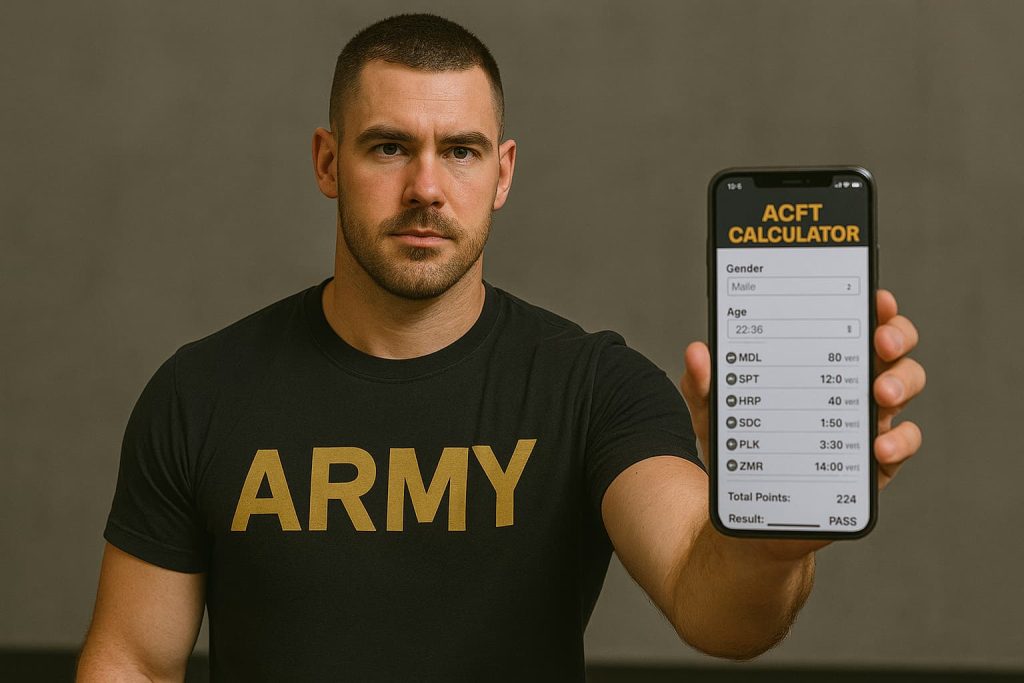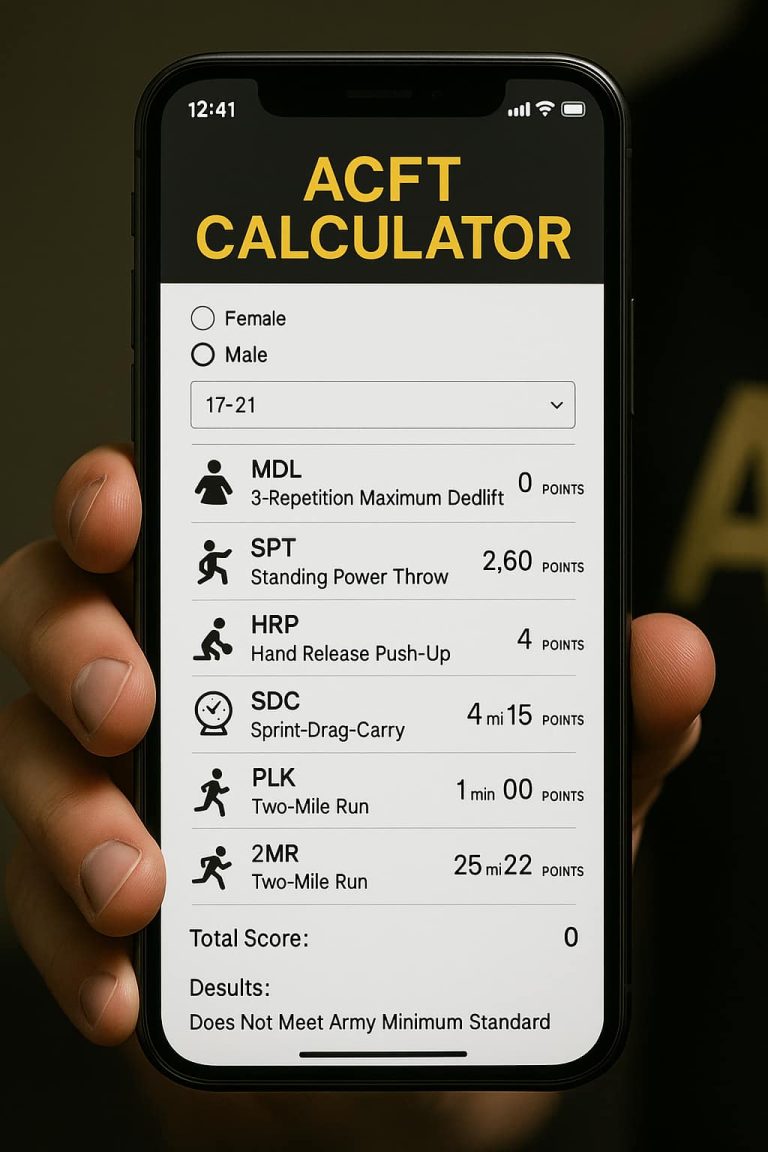ACFT Score Explained: How Points Work and What’s a Good Score?
When I was prepping for my ACFT, I’ll be honest — the scoring system confused the hell out of me at first.
I kept staring at these Army charts with tiny numbers, trying to figure out if my 320-pound deadlift was actually good or if I was just fooling myself.
After scoring 565 total points on my test (which I’m pretty proud of), I realized that understanding the scoring system isn’t just helpful — it’s absolutely crucial for maximizing your performance and promotion points.
ACFT Score Explained

Let me break it down for you in simple terms, so you don’t have to go through the same confusion I did.
The ACFT Scoring Basics: It’s Actually Pretty Simple
Here’s the foundation: each of the six ACFT events is scored from 0 to 100 points. Your total score is the sum of all six events, so the maximum possible score is 600 points.
The six events are:
- 3-Repetition Maximum Deadlift (MDL)
- Standing Power Throw (SPT)
- Hand-Release Push-Ups (HRP)
- Sprint-Drag-Carry (SDC)
- Plank (PLK)
- Two-Mile Run (2MR)
The minimum passing score for each event is 60 points, which means you need at least 360 total points to pass the entire test. Fail any single event (score below 60), and you fail the whole ACFT — no exceptions.
During my training, I used the ACFT Calculator constantly to track my progress. Instead of trying to decode those confusing Army charts every week, I could just plug in my performance numbers and instantly see my scores. Game-changer, honestly.
Score Ranges: What’s Actually Considered Good?
Let me give you the straight scoop on what different score ranges really mean:
Individual Event Scores:
- 60-69 points: Minimum standard (you’re passing, but barely)
- 70-79 points: Decent performance (shows good fitness)
- 80-89 points: Strong performance (you’re exceeding standards)
- 90-99 points: Excellent performance (you’re in great shape)
- 100 points: Maximum score (you’re a beast)
Total Score Ranges:
- 360-419 points: Passing but needs improvement
- 420-479 points: Solid performance across all events
- 480-539 points: Strong overall fitness
- 540-579 points: Excellent fitness level
- 580-600 points: Elite performance
When I first tested myself early in training, I scored 445 total. Not terrible, but I knew I could do better. The calculator helped me see exactly which events were dragging down my total score — turns out my Standing Power Throw and Sprint-Drag-Carry needed serious work.
Age and Gender: Yes, Standards Are Different (And That’s Fair)
Here’s where it gets a bit more complex, but it’s actually pretty reasonable once you understand it.
The Army recognizes that a 22-year-old male and a 45-year-old female shouldn’t be held to identical physical standards.
Age Groups:
- 17-21 years
- 22-26 years
- 27-31 years
- 32-36 years
- 37-41 years
- 42-46 years
- 47-51 years
- 52-56 years
- 57-61 years
- 62+ years
The bottom line: Older soldiers need lower raw performance to earn the same points, and the standards are adjusted between male and female soldiers. For example, a 25-year-old male might need to deadlift 340 pounds to score 100 points, while a 25-year-old female might need 230 pounds for the same score.
My take: Don’t get hung up on comparing your raw numbers to someone else’s. Focus on maximizing your score within your demographic group. The calculator automatically adjusts for your age and gender, so you don’t have to worry about doing the math yourself.
Event-by-Event Score Breakdown
Let me walk you through what good performance looks like for each event, based on my own experience:
3-Repetition Maximum Deadlift
- Minimum (60 pts): Usually 140-180 lbs depending on demographics
- Good (80 pts): Around 250-290 lbs
- Excellent (90+ pts): 300-340+ lbs
I went from deadlifting 285 to 355 pounds during my training. That improvement alone boosted my MDL score from 75 to 95 points — massive gains for my total score.
Standing Power Throw
- Minimum (60 pts): Usually 4.5-6.0 meters
- Good (80 pts): Around 8.0-9.5 meters
- Excellent (90+ pts): 10.5+ meters
This was my weakest event initially. I could barely throw 8.2 meters, which was only worth 68 points. After focusing on explosive power training, I got up to 11.1 meters for 92 points.
Hand-Release Push-Ups
- Minimum (60 pts): Usually 10-20 reps
- Good (80 pts): Around 35-45 reps
- Excellent (90+ pts): 50+ reps
These aren’t regular push-ups — the hand-release component makes them much harder. I maxed out at 67 reps, which scored 98 points and was definitely worth all those training sessions.
Sprint-Drag-Carry
- Minimum (60 pts): Usually 3:00-3:35 depending on demographics
- Good (80 pts): Around 2:15-2:45
- Excellent (90+ pts): Under 2:10
This event is pure anaerobic torture. I went from struggling to finish in 2:55 to crushing it in 2:05. The improvement from 62 points to 94 points made a huge difference in my total score.
Plank
- Minimum (60 pts): Usually 2:00-2:20
- Good (80 pts): Around 3:00-3:30
- Excellent (90+ pts): 4:00+ minutes
I actually love that they replaced sit-ups with planks. I can hold a plank for 4:35, which maxed out my score at 100 points. Much better for actual core strength.
Two-Mile Run
- Minimum (60 pts): Usually 18:00-21:00 depending on demographics
- Good (80 pts): Around 15:30-17:00
- Excellent (90+ pts): Under 15:00
Running was always my strongest event. My 13:25 time earned me 96 points and helped offset some of my weaker events early in training.
How I Used the Calculator to Maximize My Score?
Here’s the thing that really made a difference: I didn’t just train blindly and hope for the best.
Every week, I’d input my current performance into the ACFT Calculator and see exactly where I stood.
My weekly routine:
- Test 2-3 events during each workout
- Plug the numbers into the calculator immediately
- See which events were dragging down my total score
- Adjust my training focus for the following week
The calculator showed me that improving my SPT from 8.2 to 9.5 meters would boost my score by 15 points, while improving my already-strong run time by 30 seconds would only add 3 points. That insight helped me prioritize my training time effectively.
Pro tip: The calculator also helped me set realistic goals. Instead of just hoping to “do better,” I could see exactly what performance targets would get me to 500, 525, or 550+ total points.
Promotion Points: Why Your Score Really Matters
Let’s be real — this isn’t just about fitness. Your ACFT score directly impacts your promotion points, especially in today’s competitive environment.
General promotion point impact:
- 360-450 points: You’re meeting standards but not standing out
- 450-500 points: Competitive for promotion
- 500+ points: Strong advantage in promotion calculations
- 550+ points: You’re in the top tier
I know soldiers who missed promotion by just a few points, and their ACFT score was the difference-maker. Those extra 20-30 points from training smart can literally change your career timeline.
Common Mistakes I See (And How to Avoid Them)
- Mistake #1: Focusing only on events you’re already good at I wasted weeks perfecting my run time when I should have been working on power throw technique.
- Mistake #2: Not understanding the scoring system You can’t improve what you can’t measure. Use the calculator to track progress scientifically.
- Mistake #3: Training without specific score targets “Getting better” isn’t a goal. “Improving my deadlift from 285 to 320 pounds to gain 12 points” is a goal.
- Mistake #4: Ignoring the point values of improvements Not all improvements are equal. A 20-pound deadlift increase might be worth more points than shaving 15 seconds off your run time.
The Bottom Line: Knowledge Is Power
Understanding the ACFT scoring system transformed my preparation from random workouts to strategic training. When you know exactly how points are awarded, you can train smarter, not just harder.
The ACFT Calculator takes all the guesswork out of scoring. No more squinting at Army charts or wondering if your performance is actually improving. Just input your numbers and get instant, accurate results.
I used it throughout my entire 12-week training cycle, and it kept me motivated and focused on the events that mattered most for my total score. Watching my projected score climb from 445 to 565 was incredibly satisfying and kept me grinding through tough workouts.
Ready to Dominate Your ACFT?
Look, the scoring system might seem complicated at first, but it’s actually pretty straightforward once you understand the basics.
Every point matters, every event counts, and every improvement gets you closer to your goals.
Stop guessing where you stand and start tracking your progress scientifically. Head over to right now and input your current performance levels.
See exactly where you are, set specific targets for improvement, and track your progress as you train.
Whether you’re aiming to just pass, compete for promotion points, or absolutely crush the test like I did, knowing your scores is the first step toward success.
Trust me — once you understand how the points work and start tracking your progress, you’ll be amazed at how much faster you improve. Now get out there and start racking up those points!





